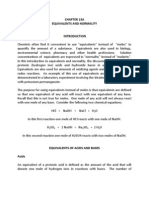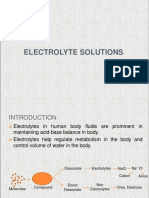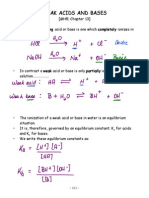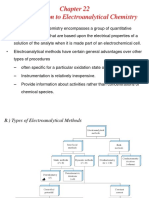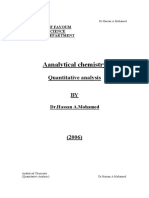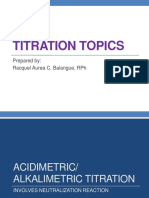Normality
Normality
Uploaded by
angelaskatsCopyright:
Available Formats
Normality
Normality
Uploaded by
angelaskatsCopyright
Available Formats
Share this document
Did you find this document useful?
Is this content inappropriate?
Copyright:
Available Formats
Normality
Normality
Uploaded by
angelaskatsCopyright:
Available Formats
NORMALITY The normality, N, of a redox reagent is n times the molarity, where n is the number of electrons donated or accepted by that
species in a chemical reaction. N = nM For example, in the half equation MnO4- + 8H+ + 5e- Mn2+ + 4H2O The normality of permanganate ion is five times its molarity, because each MnO4accepts 5e- . If the molarity of permanganate is 0.1M, what is the normality for the reaction below? MnO4- + 5Fe2+ + 8H+ Mn2+ + 5Fe3+ + 4H2O Solution: N = nM =5 x 0.1 = 0.5 N (read as 0.5 normal). Like molarity, this concentration system is based on the volume of the solution. Normality = number of equivalents of solute per liter of solution Or N = eq V Example 2. Find the normality of a solution containing 6.34 g of ascorbic acid in 250.0 mL if the relevant half-reaction is
H2O +
+ 2H+ + 2e-
Solution: Ascorbic Acid(C6H8O6) C = 6 x 12 = 72 H=8x 1 =8 O = 6 x 16 = 96___ 176 Molecular mass M = _____mass______ molecular mass = __6.34 g____ 176 g/mol = 3.60 x 10-2 mol Since, each mole contains 2 equivalents in this example, 6.34 g = (2 equiv/mol) (3.60 x 10-2 mol) = 7.20 x 10-2 equivalent
250.0 mL x __1 L__= 0.250 0 L 1000 mL
N= eq V = 7.20 x 10-2 equivalent 0.250 0 L
= 0.288 N
You might also like
- Physical Pharmacy 4Document11 pagesPhysical Pharmacy 4husseinNo ratings yet
- Analytical ChemistryDocument95 pagesAnalytical ChemistryHugo WNo ratings yet
- SAS6 Physical Pharmacy Solubility and Concentrations in Solutions 2Document33 pagesSAS6 Physical Pharmacy Solubility and Concentrations in Solutions 2Kris Aimae MorgadoNo ratings yet
- Solutions (1-47) - FinalDocument47 pagesSolutions (1-47) - FinalJiYie LeeNo ratings yet
- MODULE 2.1 and 2.2 Water and Ways of Expressing Concentration - 1Document35 pagesMODULE 2.1 and 2.2 Water and Ways of Expressing Concentration - 1hey yutNo ratings yet
- PharmAnal 5Document22 pagesPharmAnal 5Aaron Jhulian SimbitNo ratings yet
- Equivalents and NormalityDocument9 pagesEquivalents and NormalityRohan Walking Tall100% (1)
- Worksheet 6 Colligative PropertiesDocument7 pagesWorksheet 6 Colligative Propertiesani illuriNo ratings yet
- Electrolyte SolutionsDocument51 pagesElectrolyte SolutionsAina AlmaaidahNo ratings yet
- Experiment 2: Postlab Qualitative Tests For Proteins RecallDocument15 pagesExperiment 2: Postlab Qualitative Tests For Proteins RecallGrace HernandezNo ratings yet
- Substituent Effects - Organic ChemistryDocument8 pagesSubstituent Effects - Organic ChemistrytracyymendozaNo ratings yet
- Molarity, Molality and NormalityDocument6 pagesMolarity, Molality and NormalitySami FlimbanNo ratings yet
- Pa1 Unit 2 Acidimetrypdf PDF Free PDFDocument20 pagesPa1 Unit 2 Acidimetrypdf PDF Free PDFJersa Mae MaravillaNo ratings yet
- Phyphar Lab First ShiftingDocument5 pagesPhyphar Lab First ShiftingGrace HernandezNo ratings yet
- Unit 7 General Concept of Volumetric Titrimetry UST TemplateDocument22 pagesUnit 7 General Concept of Volumetric Titrimetry UST TemplateCess MontemayorNo ratings yet
- Polyfunctional Prac SetDocument6 pagesPolyfunctional Prac SetGrace Hernandez100% (1)
- BIOCHEM EXP 1 PPT Final 2 PDFDocument8 pagesBIOCHEM EXP 1 PPT Final 2 PDFEUNICE FIGUEROANo ratings yet
- Unit 2 Solutions UST TemplateDocument15 pagesUnit 2 Solutions UST TemplateCess MontemayorNo ratings yet
- Iodine ValueDocument16 pagesIodine ValueZainah Najihah ZainanNo ratings yet
- Module Anachem Acid-Base 1 PDFDocument9 pagesModule Anachem Acid-Base 1 PDFarejay castro0% (1)
- Model 1: Theory: Oxidation-Reduction MethodsDocument4 pagesModel 1: Theory: Oxidation-Reduction MethodsAliza EsplanadaNo ratings yet
- CH 13 Titrations in Analytical ChemistryDocument14 pagesCH 13 Titrations in Analytical ChemistryHenrique CostaNo ratings yet
- Redox Titration QuizDocument1 pageRedox Titration QuizChen Lit YangNo ratings yet
- Principles of Neutralization TitrationDocument32 pagesPrinciples of Neutralization TitrationAldwin CantosNo ratings yet
- Basic TheoryDocument10 pagesBasic TheoryUma Villashini Gunasekaran100% (1)
- Post Lab Qc1 2019Document42 pagesPost Lab Qc1 2019Frances SaludNo ratings yet
- Principles of Titrimetric AnalysisDocument32 pagesPrinciples of Titrimetric AnalysisFedelyn Mae AcaylarNo ratings yet
- Weak Acid Base NotesDocument49 pagesWeak Acid Base NotesJankel L PahuyoNo ratings yet
- Expression of ConcentrationDocument2 pagesExpression of ConcentrationDana FuentesNo ratings yet
- Colorimetric Determination of PH FINALDocument32 pagesColorimetric Determination of PH FINALAnn Renette UyNo ratings yet
- An Introduction To Electroanalytical ChemistryDocument27 pagesAn Introduction To Electroanalytical Chemistrymuhammad sameer ansariNo ratings yet
- Chem 41 Lab Formal Report 01 - Preparation of Buffers & Amino Acids As AmpholytesDocument13 pagesChem 41 Lab Formal Report 01 - Preparation of Buffers & Amino Acids As AmpholytesFaith VillahermosaNo ratings yet
- Surface and Interfacial PhenomenaDocument33 pagesSurface and Interfacial PhenomenaRana Mehul GNo ratings yet
- Compressed Notes For Pharm Analysis LectureDocument5 pagesCompressed Notes For Pharm Analysis LectureAce AlbercaNo ratings yet
- Chapter 14Document121 pagesChapter 14Dental BlackboardNo ratings yet
- Experiment #5 Analysis of Acetic Acid: September 8, 2016 Prof. Jeanne Grace AberionDocument33 pagesExperiment #5 Analysis of Acetic Acid: September 8, 2016 Prof. Jeanne Grace AberionShiennah Joy Linguete EupeñaNo ratings yet
- Density Specific Gravity VolumeDocument26 pagesDensity Specific Gravity VolumeJames Nevin GoNo ratings yet
- QuantitativeDocument87 pagesQuantitativeMohamed DahmaneNo ratings yet
- Analytical ChemistryDocument50 pagesAnalytical ChemistryNguyễn Trịnh Anh MinhNo ratings yet
- Conductometric Titrations: Submitted ToDocument10 pagesConductometric Titrations: Submitted ToFaraz AnjumNo ratings yet
- Acid Base & Redox TitrationDocument17 pagesAcid Base & Redox TitrationKrishanNo ratings yet
- Titration. Lab - StudentDocument5 pagesTitration. Lab - Studentshoaib2769504No ratings yet
- Unit 13 - Precipitation Titration - SubjectsDocument32 pagesUnit 13 - Precipitation Titration - SubjectsReynaldo JMNo ratings yet
- IPS - Physical Pharmacy SC Presentation 202324Document476 pagesIPS - Physical Pharmacy SC Presentation 202324DUEÑAS, MARIELNo ratings yet
- Lecture 1 - Introduction To Secondary MetabolitesDocument36 pagesLecture 1 - Introduction To Secondary MetabolitesAlec LiuNo ratings yet
- Pharmaceutical Aids and Necessities (Report Pharchem 1-Group 1)Document109 pagesPharmaceutical Aids and Necessities (Report Pharchem 1-Group 1)NicoleTrishiaDeparineNo ratings yet
- CHM 222 Complexometric Titration PDFDocument38 pagesCHM 222 Complexometric Titration PDFGlory Usoro100% (1)
- 12 Special MethodsDocument45 pages12 Special MethodsnidsNo ratings yet
- Potentiometry: Dr. Kathlia A. de Castro-Cruz Analytical Chemistry For CheDocument59 pagesPotentiometry: Dr. Kathlia A. de Castro-Cruz Analytical Chemistry For CheCyrus VizonNo ratings yet
- Types of Titrimetric AnalysisDocument62 pagesTypes of Titrimetric AnalysisJacqueline BaquiranNo ratings yet
- PharmChem-1 Lab Exp#01 - Analysis of Group I CationsDocument3 pagesPharmChem-1 Lab Exp#01 - Analysis of Group I CationsdavenNo ratings yet
- Applications of Spectroscopic TechniquesDocument20 pagesApplications of Spectroscopic Techniquesamanbioq1No ratings yet
- Chapter 4 - Ionic EquilibriumDocument55 pagesChapter 4 - Ionic EquilibriumNabilah SyazNo ratings yet
- PotentiometryDocument4 pagesPotentiometryalexpharmNo ratings yet
- Chapter 5 - Volumetric AnalysisDocument83 pagesChapter 5 - Volumetric Analysislois laneNo ratings yet
- 15 Multistep Synthesis Synthons DisconDocument38 pages15 Multistep Synthesis Synthons DisconGowtham LecturesNo ratings yet
- PotentiometryDocument7 pagesPotentiometrysuhanizah suhanizahNo ratings yet
- Exp.4-Melting and Boiling PointDocument16 pagesExp.4-Melting and Boiling Pointsisi slay100% (1)
- Normality - AWA GROUPDocument10 pagesNormality - AWA GROUPLarabel G. HumachagNo ratings yet
- Advanced Pharmaceutical analysisFrom EverandAdvanced Pharmaceutical analysisRating: 4.5 out of 5 stars4.5/5 (2)
- Hypotheses TestingDocument5 pagesHypotheses TestingangelaskatsNo ratings yet
- Inference For Two or More MeansDocument1 pageInference For Two or More MeansangelaskatsNo ratings yet
- ElectrozzDocument24 pagesElectrozzangelaskatsNo ratings yet
- Concentration UnitsDocument8 pagesConcentration UnitsAngela Kathlyn SolacitoNo ratings yet






